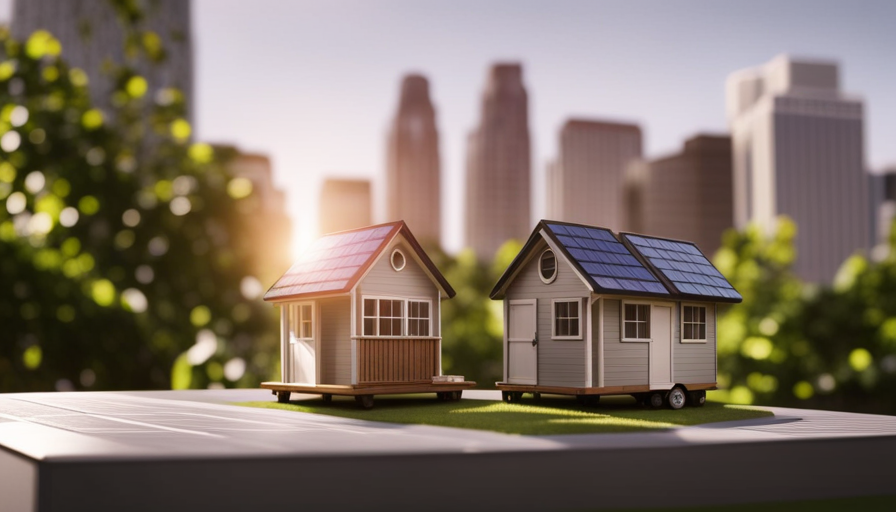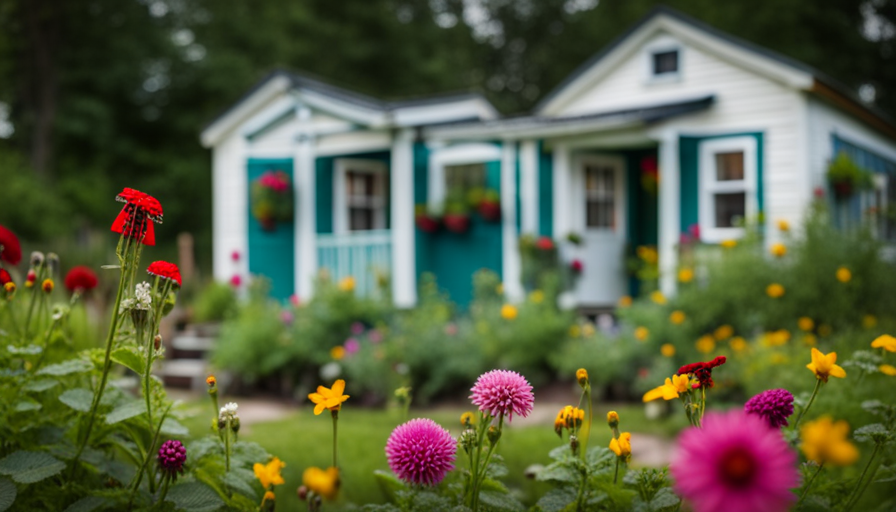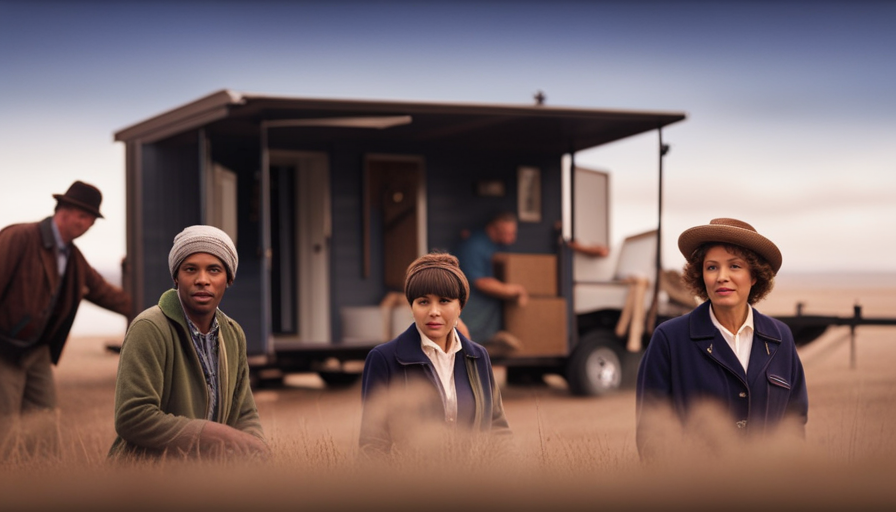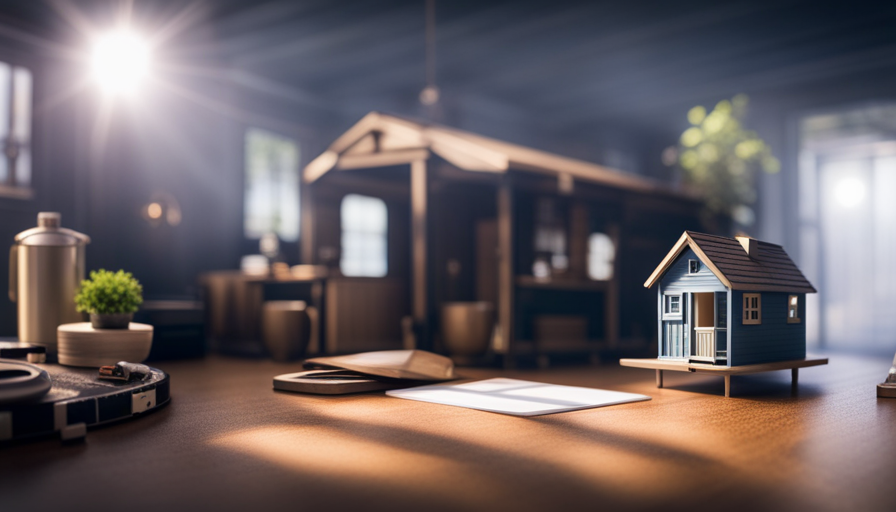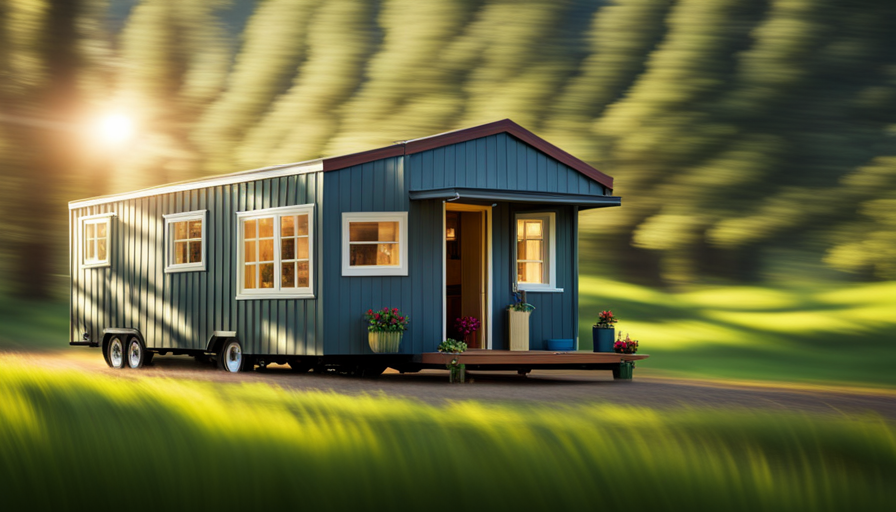Building a small house is a common dream, but what do you do if you don’t have the land to build it on? While this may seem like a big challenge, there’s no need to fret! With some creativity and resourcefulness, you can still make your tiny home dream a reality. In this article, I will share the knowledge and tips I have collected on creating a tiny home without owning land.
Now, you might be wondering how this is even possible. How can you have a tiny house without a plot of land to place it on? Well, that’s where the magic of alternative living arrangements comes in. From portable and mobile designs to utilizing temporary land options and converting existing structures, there are plenty of ways to make it work.
But it doesn’t stop there. I will also delve into the world of tiny house villages and communities, where like-minded individuals come together to create a unique living experience. Additionally, I’ll explore the options of working with tiny house builders or contractors and seeking out financing and funding opportunities.
Whether you’re looking to live off the grid or simply embrace a minimalist lifestyle, this article will provide you with the detailed information you need to build your tiny house without land.
So, let’s get started and turn your tiny house dreams into a reality!
Key Takeaways
- Building a tiny house without land can be achieved by opting for portable or mobile designs that can be easily transported.
- Renting or leasing opportunities on someone else’s land, joining a tiny house community, or exploring co-housing projects can provide support and a place to park the tiny house.
- Converting existing structures such as shipping containers, barns, garages, or sheds can be a viable option for creating a tiny house, considering factors like size, condition, location, and legal suitability.
- Researching local tiny house legislation, financing options, zoning laws, and regulations is crucial before embarking on building a tiny house without land.
Choose a Portable or Mobile Tiny House Design
If you’re looking to build your tiny house without the need for land, you’ll want to consider opting for a portable or mobile design that allows you the freedom to take your home wherever you please!
There are various portable tiny house options available that cater to different needs and preferences. One popular choice is a trailer-based design, where your tiny house is built on a trailer bed, allowing for easy transportation. This option gives you the flexibility to move your home to different locations, whether it’s for a change of scenery or to follow job opportunities.
The benefits of mobile tiny homes are numerous. Firstly, they provide a sense of adventure and freedom as you can constantly change your surroundings. Secondly, you don’t have to worry about purchasing land, paying property taxes, or dealing with zoning regulations. Additionally, if you ever decide to relocate, you can simply hitch your tiny house to a vehicle and hit the road.
Now, once you have your portable or mobile tiny house design in mind, the next step is to find alternative living arrangements that suit your lifestyle and preferences.
Find Alternative Living Arrangements
When it comes to finding alternative living arrangements for my tiny house, I’ve found that there are a few key options worth exploring.
First, I can look for renting or leasing opportunities where I can park my tiny house on someone else’s land. This allows me to enjoy the benefits of a tiny house without the commitment of owning land.
Another option is to join a tiny house community or co-housing project, where like-minded individuals come together to create a supportive and sustainable living environment. This not only provides a sense of community but also access to shared resources and amenities.
Look for Renting or Leasing Opportunities
Explore the vast expanse of rental and leasing options like a curious explorer, as you search for a place to plant the seed of your tiny house dream.
When it comes to renting options, consider looking for properties that allow for tiny house living. Some landlords may be open to the idea, especially if you can showcase the benefits of tiny house living, such as reduced environmental impact and lower utility costs.
Additionally, land leasing is another avenue to explore. Look for landowners who are willing to lease a portion of their property for you to park your tiny house on. This can provide you with the freedom and flexibility to build your tiny house without the need for purchasing land.
With these options in mind, you can take the next step and join a tiny house community or co-housing project.
Join a Tiny House Community or Co-Housing Project
Immerse yourself in the vibrant and supportive community of like-minded individuals by joining a tiny house community or co-housing project. This is a fantastic way to not only build your tiny house but also to establish lasting connections and learn from others who’ve already gone through the process.
When you join a tiny house community, you gain access to a wealth of knowledge and resources. You can attend workshops and seminars on building techniques, sustainable living, and off-grid solutions. Additionally, co-housing projects often offer shared facilities and land, reducing the financial burden and providing a sense of security.
By joining a tiny house community or co-housing project, you can tap into the collective wisdom and support of others who share your passion for minimalism and sustainable living.
Transitioning into the subsequent section about ‘utilize temporary land options’, you can explore various options for finding land to park your tiny house temporarily.
Utilize Temporary Land Options
By utilizing temporary land options, you can transform your dream of building a tiny house into a reality, no matter where you are. Temporary land options provide you with the opportunity to live in your tiny house while also exploring creative housing solutions. These options allow you to experience the benefits of tiny house living without the long-term commitment of owning land.
One option is to rent land from a private landowner or a tiny house community. This allows you to set up your tiny house on someone else’s property, giving you a temporary place to call home. Another option is to look for land-sharing programs, where you can exchange your skills or services in exchange for a place to park your tiny house. This not only provides you with a place to live but also allows you to connect with like-minded individuals who share your passion for tiny house living.
To help you visualize these temporary land options, here is a table showcasing some examples:
| Temporary Land Option | Description |
|---|---|
| Renting from a Private Landowner | Renting a spot on someone else’s property for a specific period of time. |
| Tiny House Communities | Joining a community that provides designated space for tiny houses. |
| Land-sharing Programs | Exchanging skills or services for a temporary place to park your tiny house. |
By exploring these temporary land options, you can start building your tiny house and begin living the lifestyle you’ve always dreamed of. In the next section, we will discuss how you can convert existing structures into a suitable home for your tiny house.
Convert Existing Structures
One exciting option is to repurpose existing structures to create a cozy home for your tiny house. By converting existing structures, you can save time and money while also making use of available resources.
There are various types of structures that can be repurposed, such as shipping containers, barns, garages, or even old sheds. When converting an existing structure, it’s important to consider its size, condition, and location in order to ensure it meets your needs and complies with local regulations.
Firstly, assess the structure’s size and layout to determine how it can be modified to accommodate your tiny house. You may need to remove walls, add windows or doors, or reconfigure the interior to optimize space. Additionally, consider the condition of the structure and any necessary repairs or upgrades that may be needed. This could include reinforcing the foundation, improving insulation, or updating electrical and plumbing systems.
Another important factor to consider is the location of the existing structure. It’s essential to ensure that the structure is situated on land where you have permission to build or use it as a dwelling. Utilize temporary land options such as renting or leasing land from someone who’s willing to accommodate your tiny house project.
By converting existing structures, you can create a unique and personalized tiny house while also minimizing the environmental impact of new construction. In the next section, we’ll explore the option of considering tiny house villages or communities as a way to further enhance your tiny house living experience.
Consider Tiny House Villages or Communities
When considering building a tiny house without land, one option to explore is researching existing tiny house villages or communities. These communities often have established infrastructure and resources in place, making it easier to navigate the legal and logistical aspects of living in a tiny house.
Another possibility is collaborating with others to start a tiny house community from scratch. This can be a rewarding experience as you work together to create a supportive and sustainable living environment for everyone involved.
Research Existing Tiny House Villages or Communities
If you’re looking to build your tiny house with no land, have you considered researching existing tiny house villages or communities? These unique communities have been growing in popularity, with over 200 tiny house villages or communities currently established across the United States alone.
When researching existing tiny house villages or communities, it’s important to explore the local tiny house legislation to ensure that it aligns with your needs and preferences. Additionally, you can look into the various tiny house financing options available to determine the best approach for your project.
By thoroughly researching existing tiny house villages or communities, you can gain valuable insights and ideas for your own tiny house journey. Transitioning into the next section, collaborating with others to start a tiny house community can provide even more support and resources for building your dream home.
Collaborate with Others to Start a Tiny House Community
Collaborating with others to start a tiny house community can provide an incredible network of support and resources for realizing your dream home. Through collaborative initiatives and community development, you can work together with like-minded individuals to create a thriving and sustainable tiny house community.
Here are three ways collaborating with others can benefit you in building your tiny house with no land:
-
Shared resources: By pooling your resources with others, you can collectively purchase materials, tools, and services at a lower cost, making your tiny house construction more affordable.
-
Knowledge exchange: Collaborating with others allows you to tap into a wealth of knowledge and experience. You can learn from each other’s successes and challenges, gaining valuable insights and avoiding common pitfalls.
-
Emotional support: Building a tiny house can be a daunting task, but with a community of like-minded individuals, you’ll have a support system to lean on. You can share ideas, seek advice, and celebrate milestones together.
By collaborating with others, you can lay the foundation for a successful tiny house community. Now, let’s explore tiny house-friendly areas to further enhance your journey.
Explore Tiny House-Friendly Areas
When it comes to exploring tiny house-friendly areas, one of the key points to consider is researching zoning laws and regulations. This is crucial in order to ensure that you can legally park and live in your tiny house.
It is important to find areas that have supportive policies or existing tiny house communities, as these locations are more likely to be open to the idea of tiny house living and may have specific regulations in place to accommodate it.
Research Zoning Laws and Regulations
Researching zoning laws and regulations is essential when building a tiny house with no land, as it allows you to understand the legal restrictions and requirements that may impact your project. Interestingly, a study conducted by the American Planning Association found that 57% of municipalities in the United States have regulations that restrict or prohibit tiny houses on wheels. It is crucial to become familiar with the local zoning laws before embarking on your tiny house journey. To visually represent the importance of researching regulations and finding suitable locations, consider the following table:
| Pros of Researching Zoning Laws and Regulations | Cons of Not Researching Zoning Laws and Regulations |
|---|---|
| Avoid legal issues and fines | Build in prohibited areas |
| Ensure compliance with safety standards | Encounter difficulties in obtaining utilities |
| Find suitable areas for your tiny house | Waste time and money on non-compliant locations |
| Secure necessary permits and approvals | Face potential eviction or relocation challenges |
By researching zoning laws and regulations, you can avoid unnecessary setbacks and ensure the success of your tiny house project. Moving forward, let’s explore how to look for areas with tiny house communities or supportive policies.
Look for Areas with Tiny House Communities or Supportive Policies
To increase your chances of finding a welcoming community for your tiny house, explore areas with existing tiny house communities or policies that support these unique housing options. Look for regions that have already embraced the tiny house movement and have established communities where like-minded individuals can live and thrive.
These areas may have specific zoning laws and regulations that cater to portable or permanent tiny houses, making it easier for you to find a place to park or locate your tiny home. Joining a tiny house community not only provides a sense of camaraderie and support, but also offers numerous benefits such as shared resources, reduced living expenses, and access to communal spaces.
By immersing yourself in an existing tiny house community, you can gain valuable insights and connections, making the process of building your own tiny home even more enjoyable and rewarding. When considering your options, it’s also important to utilize the expertise of tiny house builders or contractors to ensure your dream home becomes a reality.
Utilize Tiny House Builders or Contractors
Consider hiring experienced tiny house builders or contractors to help you create your dream home without the need for land. These professionals specialize in constructing portable tiny house options, which are perfect for individuals who want the freedom to move their home to different locations. By utilizing their expertise, you can ensure that your tiny house is built to the highest standards and meets all necessary regulations.
One of the main benefits of hiring contractors is that they have the knowledge and experience to guide you through the entire building process. They’ll help you design a layout that maximizes space and functionality, ensuring that every square inch of your tiny house is utilized efficiently. Additionally, they can assist with obtaining the necessary permits and navigating any zoning restrictions that may apply.
Furthermore, contractors often have established relationships with suppliers and can help you source high-quality materials at a reasonable cost. They know which products are best suited for tiny house construction and can recommend the most durable options.
Once your tiny house is complete, you can seek out financing and funding options to make your dream a reality. Whether it’s through loans, grants, or alternative financing methods, there are various ways to secure the necessary funds for your project.
Seek Out Financing and Funding Options
If you’re looking to turn your dream of living in a tiny house into a reality, it’s important to explore different financing and funding options.
There are several ways to finance your tiny house project, even if you don’t currently own land. One option is to seek out financing specifically designed for tiny homes. Some financial institutions offer loans or mortgages specifically tailored for tiny house construction. These loans typically have favorable terms and interest rates, making it easier for you to fund your project.
Another option is to explore crowdfunding opportunities. Crowdfunding platforms, such as Kickstarter or GoFundMe, allow you to create a campaign to raise funds for your tiny house. You can share your story, plans, and vision with potential donors who may be willing to contribute to your project. This can be a great way to gather support and financial backing from a wide network of people who believe in your dream.
By exploring different financing and funding options, you can find the resources you need to build your tiny house, even without owning land. Once you have secured the necessary funds, you can then move on to the next step: planning for off-grid living.
Plan for Off-Grid Living
Once you’ve secured financing and funding, it’s time to envision a self-sufficient lifestyle off the grid in your cozy, sustainable haven. Living off the grid means relying on your own resources for energy and water, and it requires careful planning and consideration. Here are three key elements to consider when planning for off-grid living:
-
Off-grid energy solutions: Generating your own electricity is crucial when living off the grid. Solar panels are a popular choice for tiny houses, providing clean and renewable energy. You can also explore wind turbines or hydroelectric systems depending on your location and resources. Investing in energy-efficient appliances and LED lighting will help maximize your energy usage.
-
Sustainable water sources: Access to clean water is essential for off-grid living. Consider installing rainwater collection systems to harvest water for daily use. Implementing water-saving fixtures and appliances, like low-flow toilets and showerheads, will help conserve water. Additionally, you may want to explore options for water filtration and purification to ensure a safe and reliable water supply.
-
Waste management: Living off the grid requires proper waste management. Composting toilets are an eco-friendly option that helps reduce water usage and produces nutrient-rich compost. Implementing a greywater system can also help recycle and reuse water from sinks and showers for irrigation purposes.
Transitioning into the subsequent section about embracing a minimalist lifestyle, it’s important to remember that off-grid living goes hand in hand with simplifying and minimizing our footprint on the environment.
Embrace a Minimalist Lifestyle
When it comes to planning for off-grid living, one of the key aspects to consider is embracing a minimalist lifestyle. Living with less has countless benefits, especially when it comes to building a tiny house with no land.
By embracing minimalism, you’ll be able to create a living space that’s not only functional but also aesthetically pleasing. With limited square footage, every item you choose to include in your tiny house becomes crucial. It forces you to prioritize and only keep the essentials, which ultimately leads to a clutter-free and organized living environment.
Living with less also means reducing your environmental footprint. By eliminating excess belongings, you consume less, produce less waste, and require fewer resources. This aligns perfectly with the off-grid lifestyle, where self-sufficiency and sustainability are key values.
Furthermore, minimalism promotes a sense of freedom and flexibility. It allows you to focus on experiences rather than material possessions. With fewer things to maintain and worry about, you can spend more time exploring nature, pursuing hobbies, and connecting with loved ones.
Embracing a minimalist lifestyle is essential when building a tiny house with no land. It not only helps you create a functional and aesthetically pleasing living space but also aligns with the values of off-grid living, such as sustainability and freedom. Living with less truly has its own unique set of benefits.
Frequently Asked Questions
What are some financing options for building a tiny house?
When it comes to financing options for building a tiny house, there are a few routes you can take.
One option is to rent land for your tiny house, avoiding the pesky burden of actually owning it. Renting allows you to focus on the construction process without the hassle of purchasing property.
Alternatively, you could consider buying land for your tiny house, providing a sense of stability and ownership. Both options have their pros and cons, so weigh them carefully before making a decision.
How can I find temporary land options for my tiny house?
Finding land for a tiny house can be challenging, but there are temporary land options available. One option is land sharing, where you collaborate with someone who has unused land and agree to share the space for a period of time.
Another option is land lease, where you rent a piece of land for your tiny house. Both options require thorough research and negotiation to ensure a suitable arrangement.
Online platforms and local community organizations can be helpful resources for finding these temporary land options.
Are there any specific areas that are more friendly towards tiny houses?
There are indeed specific areas that are more friendly towards tiny houses, such as tiny house communities. These communities are designed to accommodate tiny houses and often have zoning regulations in place that allow for their construction.
They provide a supportive and like-minded community where you can connect with others who share the same lifestyle. By joining a tiny house community, you can benefit from their knowledge and experience, making your tiny house journey even more enjoyable.
Can I convert an existing structure into a tiny house?
Converting an existing structure into a tiny house is a great way to save time and money. However, it’s important to be aware of zoning restrictions in your area. Make sure to check with local authorities to ensure that you can legally renovate the structure into a residential dwelling.
Additionally, consider the structural integrity of the building and any necessary modifications that need to be made to accommodate a tiny house design.
What are some off-grid living considerations for a tiny house?
When it comes to off-grid living in a tiny house, there are a few key considerations to keep in mind.
First and foremost, sustainable energy options are essential. Investing in solar panels or a wind turbine can provide you with reliable power.
Additionally, implementing water conservation techniques, such as rainwater harvesting and greywater systems, will help you minimize your water usage.
Living off-grid requires careful planning and resource management, but the rewards of self-sufficiency are well worth it.
Conclusion
In conclusion, building a tiny house with no land may seem like a daunting task, but with the right planning and resources, it can be a rewarding and fulfilling journey.
Remember the old saying, "Home is where the heart is." With determination and creativity, you can create a cozy and comfortable space that truly feels like home, regardless of where it’s located.
So don’t let the lack of land hold you back from pursuing your tiny house dreams. Embrace the adventure and enjoy the freedom of living simply and sustainably.
Hi, I’m Emma. I’m the Editor in Chief of Tiny House 43, a blog all about tiny houses. While tree houses are often associated with childhood, they can be the perfect adult retreat. They offer a cozy space to relax and unwind, surrounded by nature. And since they’re typically built on stilts or raised platforms, they offer stunning views that traditional homes simply can’t match. If you’re looking for a unique and romantic getaway, a tree house tiny house might just be the perfect option.
